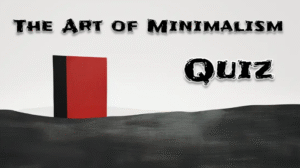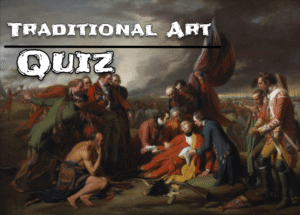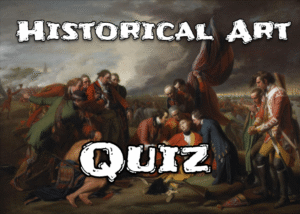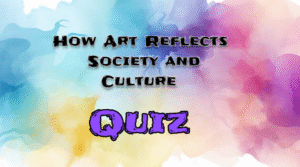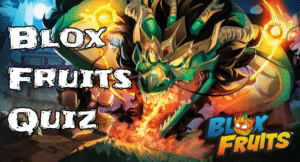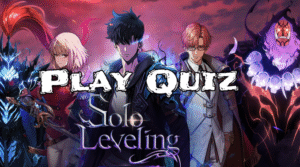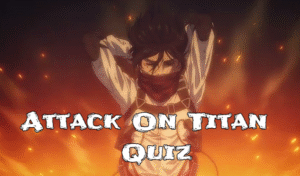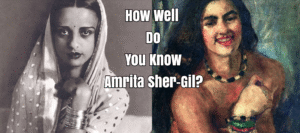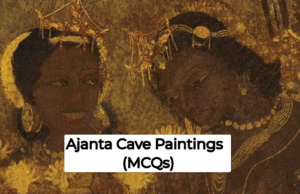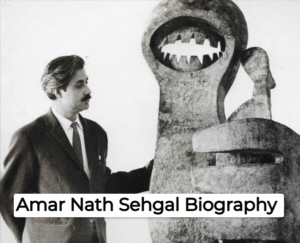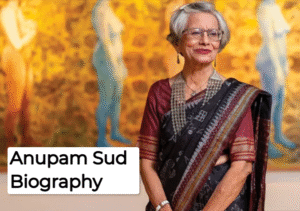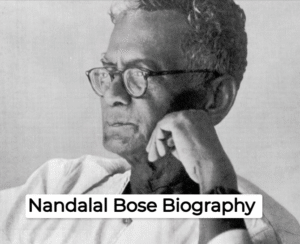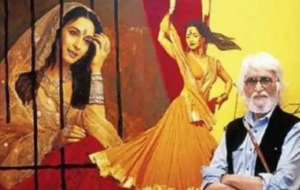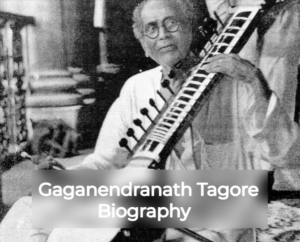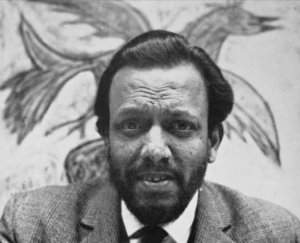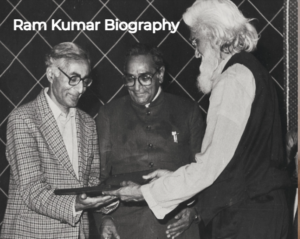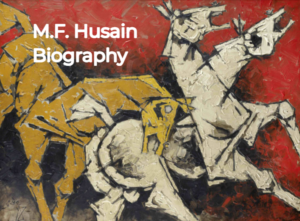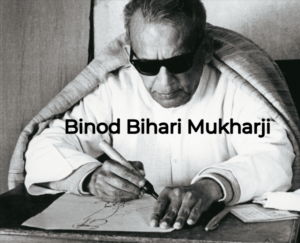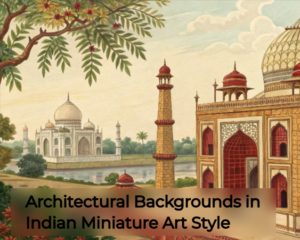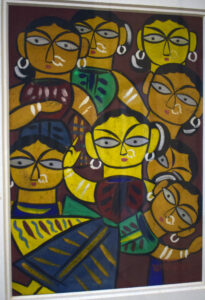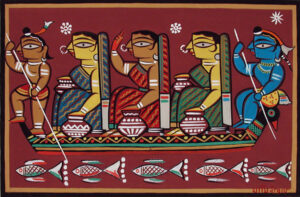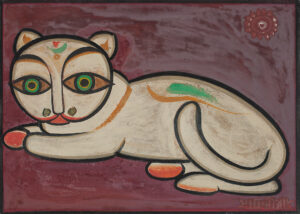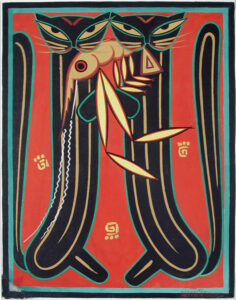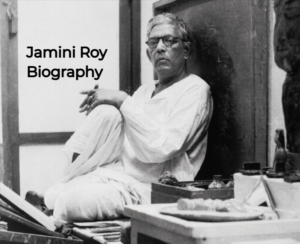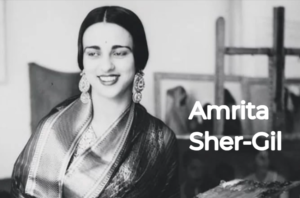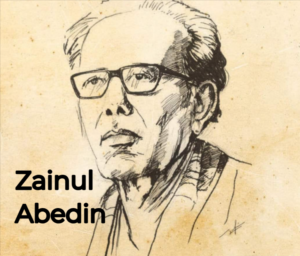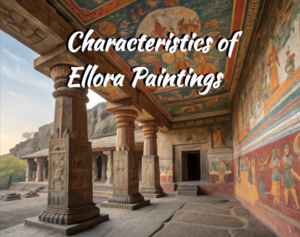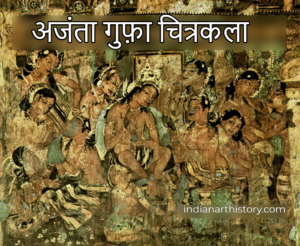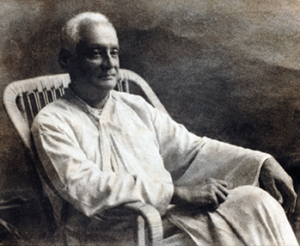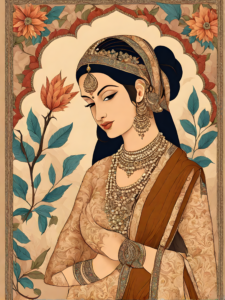Table of Contents
Jamini Roy (1887-1972)
As early as the 1930s, Jamini Roy had anticipated the current vogue amongst the artists to draw upon folk-art in fashioning artwork.
He attempted to create a distinct indigenous style in seeking inspiration from folk-art traditions as against the elitist approach of the Bengal School.
He found a quality of freshness, directness, and robustness in the artistic spirit that still survived in the scrolls, the bazaar paintings of Kalighat, in the Puja images, in toys and dolls and the hordes of artifacts created for rituals—all synthesized with the visual effects of kanthas and alpanas.
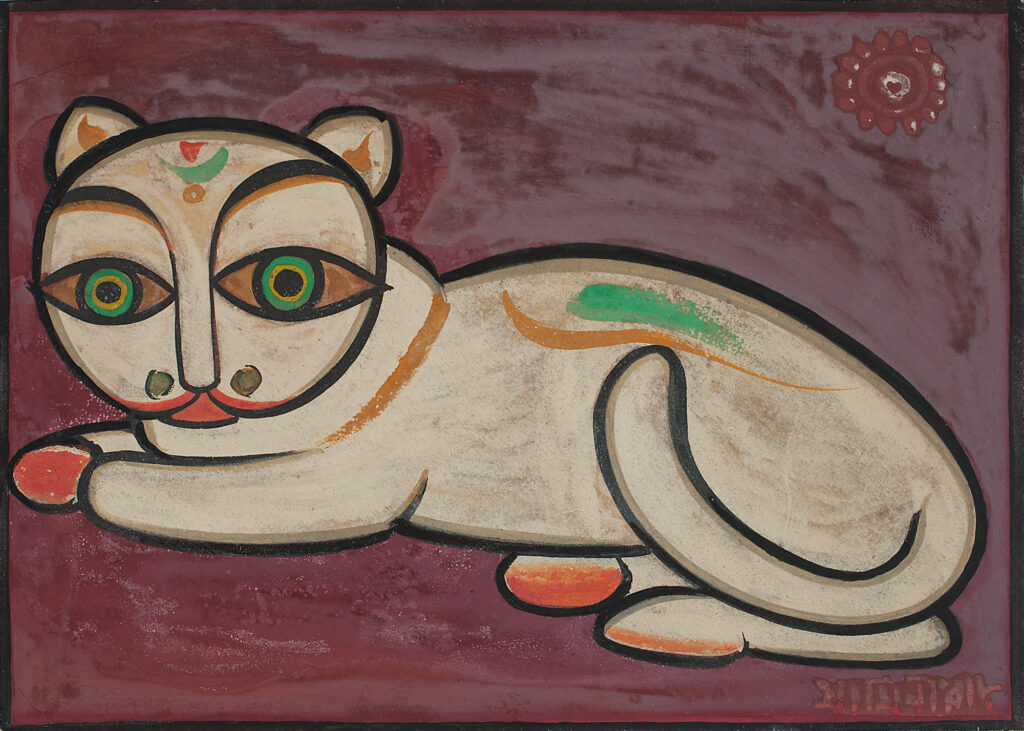
He abandoned his interest in portraiture in oils and the ‘wistful sentimentality’ of Abanindranath’s style after 1910.
He was attracted to the folk- art sources, adopting not only the freest possible manner, characteristic of native folk arts, to shape the figures in his works, but also formal ideas from Orissan and Jain manuscript illustrations of the medieval period.
After the mid-1920s he adopted an increasing use of firm and majestic curves and simple forms. He also changed his palette to mineral and vegetable dyes popularly used in villages, so as to fully identify with the village ethos.
His style, however, gradually became more decorative than poetic or sensuous. He moved away from Kalighat, although he retained some of its characteristics like the large eyes and the oval faces.
In some of his works Of the early 1930s, the stress is on the vertical rigid forms reminiscent of Byzantine icon paintings.
His paintings on the theme of Christ and the satirical paintings of animals, like those of cats with protruding eyes, clearly show the influence of the Jain School.
But, by and large, his paintings are marked by the conventional features of the native folk paintings, i.e. the flattening out of design in-depth, and of voluminous and otherwise massive forms, by omitting light and shade, and use of pure and positive colors in the interaction of their tonal quality and strength.
Jamini Roy’s paintings are a sheer expression of rhythmic lines drawn with curved and elliptic sweeps that define the robust forms of his figures.
He seems to be subordinating everything to the repetitive decorative rhythm in his panel pictures but not in his sketches, some of which are powerful spontaneous expressions.
He added an element of subtlety and sophistication to the simplistic painting of Kalighat, resulting in a strongly individualistic style.
One may wonder why Jamini Roy adopted a style based on folk-art, which, as is well known, he did after a great deal of heartsearching.
Starting his career as a portrait painter in the Western academic tradition and later experimenting with impressionism, he, subsequently discontinued both.
And though the Bengal School was then in the ascendant, he found it too eclectic to be attracted to it.
To overcome this stalemate in the art scene of that time, he strove to strike a new path by turning to native folk-art traditions wherein he discovered the art impulses and genius of his own people.
He, however, did not foresee that the folk-art style he adopted would, in course of time, lead him into a blind alley.
For, unfortunately, his enthusiastic endeavor to strive for Indianness resulted in a ‘factory’ producing Jamini Roys for the elite.
Though artistic control plays a quiet but crucial role in Jamini Roy’s paintings, it raises questions about the significance of creativity in art.
In his search for finding an identity, he styled his artistic activities as a ‘Patua’—the Bengal folk painter. For, he compared his free repetitious approach to that of the ‘Patua’.
Jamini Roy’s stimulus-response model is based on emotionally charged and decorative religious content which, though necessary, is not sufficient for creative expression.
Mere sensation ‘furnishes’ the mind with nothing whatsoever; it leaves no legible character on the ‘white paper’ within us.
For, art is an expression of a totally imaginative creative experience. How- ever, Jamini Roy’s art had nationalistic significance, especially when India was trying to free itself from the clutches of the political and cultural influences of the West.
No one, perhaps, knows with certainty whether Jamini Roy was heading in the right direction; for no one has subsequently followed his approach or style concertedly.
How far his explorations of the aesthetic norms of folk- art were successful in reviving the spirit of indigenous art traditions is a debatable question.
And how valid are the aesthetic norms of bygone days for artistic expression today, especially when the present-day artist faces a vast array of material, styles, and traditions all of which are equally internationally valid? Perhaps time only will decide whether Jamini Roy’s pursuit of artistic labor was successful or not.
Be that as it may, we must remember that Jamini Roy was the first artist to prominently and creatively use folk-art at a time when more and more Indian artists were attracted to alien art forms.
Here are some of Jamini Roy’s famous paintings, including their year, media, and name:
| Painting Name | Year | Media |
|---|---|---|
| Bride and Two Companions | 1940s | Tempera on Cardboard |
| Krishna and Balarama | 1940s | Tempera on Paper |
| Mother and Child | 1940s | Tempera on Cloth |
| Three Pujarinis | 1950s | Tempera on Board |
| Santal Boy with Drum | 1935 | Tempera on Canvas |
| Gopini | 1940s | Tempera on Paper |
| St. Ann and the Blessed Virgin | 1945 | Tempera on Canvas |
| Cats Sharing a Prawn | 1940s | Tempera on Canvas |
| Ravana, Sita, and Jatayu | 1940s | Tempera on Cloth |
| Ramayana Series | 1940s | Tempera on Paper |
| Queen on Tiger | 1930s | Tempera on Paper |
| Makara and a Flock of Fish | 1940s | Tempera on Board |
| Radha and Krishna | 1940s | Tempera on Cloth |
| Seated Woman with Hookah | 1940s | Tempera on Board |
| Chaitanya and His Followers | 1940s | Tempera on Cloth |
| Woman in White Sari | 1940s | Tempera on Canvas |
| Blue Krishna with Gopis | 1940s | Tempera on Board |
| Woman Holding a Lotus | 1950s | Tempera on Canvas |
| Ganesh Janani | 1940s | Tempera on Cloth |
| Dancing Ganesha | 1940s | Tempera on Board |
Jamini Roy was known for his use of earthy colors, bold outlines, and influence from folk art, especially Kalighat paintings.
Chart of Jamini Roy’s paintings from the 1930s, including their year, media, and name:
| Painting Name | Year | Media |
|---|---|---|
| Queen on Tiger | 1930s | Tempera on Paper |
| Santal Boy with Drum | 1935 | Tempera on Canvas |
| Woman with Pitcher | 1930s | Tempera on Board |
| Seated Woman in Sari | 1930s | Tempera on Cloth |
| Mother and Child | 1930s | Tempera on Canvas |
| Woman Holding a Bird | 1930s | Tempera on Paper |
| Dancing Girl | 1930s | Tempera on Board |
| Baul Musician | 1930s | Tempera on Cloth |
| Krishna with Cows | 1930s | Tempera on Paper |
Jamini Roy’s 1930s works marked his transition from Western-style academic painting to a more folk-art-inspired style, using bold lines and natural pigments.
Chart of Jamini Roy’s paintings from the 1940s, including their year, media, and name:
| Painting Name | Year | Media |
|---|---|---|
| Bride and Two Companions | 1940s | Tempera on Cardboard |
| Krishna and Balarama | 1940s | Tempera on Paper |
| Mother and Child | 1940s | Tempera on Cloth |
| Gopini | 1940s | Tempera on Paper |
| Cats Sharing a Prawn | 1940s | Tempera on Canvas |
| Ravana, Sita, and Jatayu | 1940s | Tempera on Cloth |
| Ramayana Series | 1940s | Tempera on Paper |
| Makara and a Flock of Fish | 1940s | Tempera on Board |
| Radha and Krishna | 1940s | Tempera on Cloth |
| Seated Woman with Hookah | 1940s | Tempera on Board |
| Chaitanya and His Followers | 1940s | Tempera on Cloth |
| Woman in White Sari | 1940s | Tempera on Canvas |
| Blue Krishna with Gopis | 1940s | Tempera on Board |
| Ganesh Janani | 1940s | Tempera on Cloth |
| Dancing Ganesha | 1940s | Tempera on Board |
During the 1940s, Jamini Roy fully embraced the folk art style, using natural pigments, simplified forms, and strong outlines inspired by Kalighat paintings.
Chart of Jamini Roy’s paintings from the 1950s, including their year, media, and name:
| Painting Name | Year | Media |
|---|---|---|
| Three Pujarinis | 1950s | Tempera on Board |
| Woman Holding a Lotus | 1950s | Tempera on Canvas |
| Black Horse | 1950s | Tempera on Paper |
| Dancing Figure | 1950s | Tempera on Cloth |
| Mother and Child | 1950s | Tempera on Board |
| Krishna with Flute | 1950s | Tempera on Paper |
| Woman with Flower | 1950s | Tempera on Canvas |
By the 1950s, Jamini Roy had fully established his folk-art-inspired style, using bold colors, simplified figures, and themes from rural life and mythology.
Chart of Jamini Roy’s paintings from the 1960s
Jamini Roy’s artistic peak was between the 1930s and 1950s, and he created fewer notable works in the 1960s. However, here are some of his paintings from that period:
| Painting Name | Year | Media |
|---|---|---|
| Woman with Red Bindi | 1960s | Tempera on Board |
| Mother and Child | 1960s | Tempera on Paper |
| Krishna with Gopis | 1960s | Tempera on Cloth |
| Santal Couple | 1960s | Tempera on Canvas |
| Seated Woman in Blue Sari | 1960s | Tempera on Board |
By the 1960s, Jamini Roy had already received national recognition for his contribution to Indian modern art, and his works continued to reflect folk traditions and mythology.
Jamini Roy continued his folk-art-inspired style in the 1960s, focusing on themes of rural life, mythology, and simplicity. His works during this period maintained his signature use of bold outlines, earthy colors, and tempera on materials like paper, board, and cloth.
Many of his paintings from this time were variations of his earlier works, as he refined and repeated themes such as Mother and Child, Krishna with Gopis, and Santal Life.
In the 1960s, Jamini Roy continued to refine his unique folk-art style, drawing inspiration from traditional Kalighat paintings, Bengali folk art, and rural life. His works from this period followed the same artistic principles he had developed earlier but with more emphasis on simplification, minimalism, and repetition of themes.
Key Features of Jamini Roy’s Art in the 1960s:
- Bold Black Outlines: He used thick, strong outlines to define figures, much like traditional Indian folk art.
- Limited Color Palette: His colors were mostly earthy tones, including ochre, red, blue, green, and white, often made from natural pigments.
- Religious and Folk Themes: He focused on Hindu mythology (Krishna, Radha, Gopis), rural Bengali life (Santal couples, musicians, and dancers), and mother-child relationships.
- Use of Traditional Materials: He avoided oil paints and canvas, preferring tempera on cloth, board, or paper.
- Flat, Two-Dimensional Figures: His figures lacked shading and depth, appearing flat but expressive.
Notable Paintings from the 1960s:
| Painting Name | Media |
|---|---|
| Woman with Red Bindi | Tempera on Board |
| Mother and Child | Tempera on Paper |
| Krishna with Gopis | Tempera on Cloth |
| Santal Couple | Tempera on Canvas |
| Seated Woman in Blue Sari | Tempera on Board |
Even in his later years, Jamini Roy’s art remained deeply connected to Indian traditions, folk culture, and simplicity. His work influenced many modern Indian artists and remains highly valued today.
Jamini Roy’s Artistic Techniques and Influences
Jamini Roy was one of India’s most celebrated modern artists, known for rejecting Western artistic traditions and embracing Indian folk art. His work was deeply influenced by Bengali rural culture, Kalighat paintings, and temple art.
1. Artistic Techniques Used by Jamini Roy
A. Use of Traditional Materials
- He abandoned oil paints and canvas, using tempera (a mixture of pigment and water) on cloth, board, and paper.
- He preferred natural colors made from organic sources, such as:
- Red: From crushed stones and flowers
- Yellow: From turmeric
- Blue: From indigo
- Black: From soot
- White: From crushed shells
B. Simplified, Folk-Inspired Figures
- His figures were flat, two-dimensional, and outlined in bold black lines, much like traditional Kalighat paintings.
- He used minimal details to keep the focus on form and emotion rather than realism.
- The eyes in his paintings were large and expressive, influenced by Indian iconography.
C. Limited Color Palette
- He used earthy and primary colors instead of Western-style shading or realism.
- Colors were applied in flat, unblended areas, creating a striking and bold effect.
D. Repetition of Themes
- Roy painted multiple versions of his subjects, refining them over time.
- His recurring themes included:
- Hindu mythology (Krishna, Radha, Ramayana scenes)
- Mother and child (symbolizing maternal love and Indian motherhood)
- Bengali village life (Santals, musicians, dancers)
- Animals (Cats, horses, owls, and fish)
2. Major Influences on Jamini Roy
A. Kalighat Paintings
- Kalighat paintings originated near the Kalighat Temple in Kolkata and were created by local artisans.
- These paintings had bold lines, vibrant colors, and religious themes, all of which Roy incorporated into his work.
B. Bengali Folk Art and Rural Traditions
- Roy was deeply inspired by Bengali patachitra (scroll paintings) and terracotta temple carvings.
- He painted Santals (an indigenous community) with bright costumes and musical instruments, capturing their lively culture.
C. Ajanta Cave Paintings
- The ancient Ajanta cave murals influenced Roy’s use of flat compositions, elongated figures, and spiritual themes.
D. Western Training and Rejection of Realism
- Initially trained in Western classical painting at the Government College of Art & Craft, Kolkata, Roy mastered European styles.
- However, he rejected realism and Impressionism, turning to Indian folk traditions to create an authentic national art style.
3. Impact of Jamini Roy’s Art
- He was one of the first Indian artists to develop a truly “Indian modern art” style, free from European influences.
- His work was affordable and accessible, making art available beyond the elite class.
- He was awarded the Padma Bhushan (India’s third-highest civilian award) in 1954 for his contribution to art.
- Today, his paintings are highly valued and displayed in major museums, including the National Gallery of Modern Art (NGMA) in New Delhi.
Conclusion
Jamini Roy’s work was a revolution in Indian art, blending tradition with modernity. His use of folk themes, natural colors, bold outlines, and simplified forms made his art timeless and unique.
Read More About Famous Artists:
Somnath Hore, Dhan Raj Bhagat, Ramkinkar Vaij, Arpana Caur, Jai Zharotia, Gogi Saroj Pal, Vivan Sundaram, Manjit Bawa, Jatin Das, Biren De, Gulam Mohammad Sheikh, Arpita Singh, A Ramachandran, Om Prakash, Shanti Dave, Bishamber Khanna, Jagdish Swaminathan, Anjolie Ela Menon, Satish Gujral, G.R. Santosh
- Realism vs. Abstract Art | Quiz
 Realism vs. Abstract Art Quiz Restart Quiz let currentQuestion = 0; let score = 0; …
Realism vs. Abstract Art Quiz Restart Quiz let currentQuestion = 0; let score = 0; … - The Art of Minimalism | Quiz
 The Art of Minimalism Quiz Restart Quiz let currentQuestion = 0; let score = 0; …
The Art of Minimalism Quiz Restart Quiz let currentQuestion = 0; let score = 0; … - Traditional Art Quiz
 Traditional Art Quiz Restart Quiz let currentQuestion = 0; let score = 0; const quizContainer …
Traditional Art Quiz Restart Quiz let currentQuestion = 0; let score = 0; const quizContainer … - Historical Art Quiz
 Historical Art Quiz Restart Quiz let currentQuestion = 0; let score = 0; const quizContainer …
Historical Art Quiz Restart Quiz let currentQuestion = 0; let score = 0; const quizContainer … - How Art Reflects Society and Culture Quiz
 How Art Reflects Society and Culture Quiz Restart Quiz let currentQuestion = 0; let score …
How Art Reflects Society and Culture Quiz Restart Quiz let currentQuestion = 0; let score … - The Role of Art in Mental Health and Therapy Quiz
 The Role of Art in Mental Health and Therapy Quiz Restart Quiz let currentQuestion = …
The Role of Art in Mental Health and Therapy Quiz Restart Quiz let currentQuestion = … - Gaming Characters Quiz
 Gaming Characters Quiz Restart Quiz let currentQuestion = 0; let score = 0; const quizContainer …
Gaming Characters Quiz Restart Quiz let currentQuestion = 0; let score = 0; const quizContainer … - Blox Fruits Quiz
 Blox Fruits Quiz Restart Quiz let currentQuestion = 0; let score = 0; const quizContainer …
Blox Fruits Quiz Restart Quiz let currentQuestion = 0; let score = 0; const quizContainer … - Solo Leveling Quiz
 Solo Leveling Quiz Restart Quiz let currentQuestion = 0; let score = 0; const quizContainer …
Solo Leveling Quiz Restart Quiz let currentQuestion = 0; let score = 0; const quizContainer … - How Well Do You Know Dragon Ball Z | Quiz
 Dragon Ball Z Quiz Restart Quiz let currentQuestion = 0; let score = 0; const …
Dragon Ball Z Quiz Restart Quiz let currentQuestion = 0; let score = 0; const … - Attack On Titan Quiz
 Attack on Titan Quiz Restart Quiz let currentQuestion = 0; let score = 0; const …
Attack on Titan Quiz Restart Quiz let currentQuestion = 0; let score = 0; const … - How Well Do You Know Naruto Uzumaki
 Naruto Quiz Restart Quiz let currentQuestion = 0; let score = 0; const quizContainer = …
Naruto Quiz Restart Quiz let currentQuestion = 0; let score = 0; const quizContainer = … - One Piece Quiz
 One Piece Quiz Restart Quiz let currentQuestion = 0; let score = 0; const quizContainer …
One Piece Quiz Restart Quiz let currentQuestion = 0; let score = 0; const quizContainer … - How Well Do You Know Amrita Sher-Gil?
 Question 1 Amrita Sher-Gil is known as:A) The Queen of Mughal ArtB) The Pioneer of …
Question 1 Amrita Sher-Gil is known as:A) The Queen of Mughal ArtB) The Pioneer of … - GK Quiz
 Modern Art Quiz Restart Quiz // Additional 15 questions on Modern Art { question: “Who …
Modern Art Quiz Restart Quiz // Additional 15 questions on Modern Art { question: “Who … - How Well Do You Know Amrita Sher-Gil?
 Quiz: How Well Do You Know Amrita Sher-Gil? Start Quiz Next Your Score: /20 Restart …
Quiz: How Well Do You Know Amrita Sher-Gil? Start Quiz Next Your Score: /20 Restart … - Blox Fruits Quiz
 Blox Fruits Quiz NEXT RESTART QUIZ let currentQuestion = 0; let score = 0; const …
Blox Fruits Quiz NEXT RESTART QUIZ let currentQuestion = 0; let score = 0; const … - Mine Craft Quiz
 Minecraft Quiz NEXT RESTART QUIZ NEXT: Mine Craft Quiz Can You Name These Iconic Actors?
Minecraft Quiz NEXT RESTART QUIZ NEXT: Mine Craft Quiz Can You Name These Iconic Actors? - Ajanta Cave Paintings (MCQs)
 100 multiple choice questions (MCQs) about Ajanta Cave Paintings, divided into categories 🏛️ General Information 🕰️ Historical Context 🖌️ Art …
100 multiple choice questions (MCQs) about Ajanta Cave Paintings, divided into categories 🏛️ General Information 🕰️ Historical Context 🖌️ Art … - Amar Nath Sehgal Biography, Childhood, Life, Artworks, Media, Awards, Exhibitions, Career + Legacy Guide + Top 15 Insights
 Amar Nath Sehgal (b. 1922) A philosopher, poet, artist and craftsman, Amar Nath Sehgal’s unique …
Amar Nath Sehgal (b. 1922) A philosopher, poet, artist and craftsman, Amar Nath Sehgal’s unique … - Anupam Sud’s Contribution to Women in Art
 Anupam Sud holds a unique and powerful place in the history of Indian art, particularly …
Anupam Sud holds a unique and powerful place in the history of Indian art, particularly … - Anupam Sud Biography: Untold Legacy & 15 Insightful Facts About the Iconic Printmaker
 Anupam Sud Biography explores the life, legacy, and powerful impact of one of India’s most …
Anupam Sud Biography explores the life, legacy, and powerful impact of one of India’s most … - Nandalal Bose Biography | Life, Paintings
 Nandalal Bose (1882-1966) Even as a young student at the Khudiram Bose’s Central Collegiate School, …
Nandalal Bose (1882-1966) Even as a young student at the Khudiram Bose’s Central Collegiate School, … - Anupam Sud Biography | Life, artworks
 Anupam Sud (b.1944) Anupam Sud, an outstanding graphist, has adopted printmaking, not only for artistic …
Anupam Sud (b.1944) Anupam Sud, an outstanding graphist, has adopted printmaking, not only for artistic … - Location Tracker App: Just Enter a Mobile Number and See Anyone’s Live Location—Right on Your Phone!
 Learn how to use Google Maps as a free Location Tracker App—no subscription, zero cost, …
Learn how to use Google Maps as a free Location Tracker App—no subscription, zero cost, … - MF Hussain Painting and Madhuri Dixit: A Captivating Fusion of Art and Bollywood
 Explore the iconic MF Hussain paintings of Madhuri Dixit and the deep artistic connection between …
Explore the iconic MF Hussain paintings of Madhuri Dixit and the deep artistic connection between … - Ved Nayar Biography | Life, artworks
 Ved Nayar (b.1933) With the spread of installation art in the 1990s, there has been …
Ved Nayar (b.1933) With the spread of installation art in the 1990s, there has been … - Sankho Chaudhuri Biography | Life Artworks
 Sankho Chaudhuri (b.1916) Sankho Chaudhuri is n product Of a period in our history in …
Sankho Chaudhuri (b.1916) Sankho Chaudhuri is n product Of a period in our history in … - Gaganendranath Tagore Biography | Life, Paintings
 Gaganendranath Tagore (1867-1938) Gaganendranath Tagore, eldest brother of Abanindranath Tagore, was only seventeen years of …
Gaganendranath Tagore (1867-1938) Gaganendranath Tagore, eldest brother of Abanindranath Tagore, was only seventeen years of … - F.N. Souza Biography: Life, Art, and Legacy of a Modernist Rebel
 Introduction Ever heard of an artist who painted saints and sinners with the same passion? …
Introduction Ever heard of an artist who painted saints and sinners with the same passion? … - F.N. Souza Biography | Life, Artworks
 F.N. Souza has produced an imaginative body of figurative paintings that are independent of any …
F.N. Souza has produced an imaginative body of figurative paintings that are independent of any … - Pran Nath Mago Biography
 A painter, designer, art educationist, and art critic, Mago retired as a professor in fine …
A painter, designer, art educationist, and art critic, Mago retired as a professor in fine … - What is the art style of Ram Kumar?
 Ram Kumar (1924–2018) was a prominent Indian artist whose work evolved significantly over his career, …
Ram Kumar (1924–2018) was a prominent Indian artist whose work evolved significantly over his career, … - Ram Kumar Biography – Life, Legacy, and Artistic Mastery
 Introduction to Ram Kumar: The Visionary Indian Artist Ram Kumar stands as a towering figure …
Introduction to Ram Kumar: The Visionary Indian Artist Ram Kumar stands as a towering figure … - Ram Kumar
 Ram Kumar, an important landscape painter, studied under Andre Lhote and Fernand Leger, and has …
Ram Kumar, an important landscape painter, studied under Andre Lhote and Fernand Leger, and has … - Tyeb Mehta
 Tyeb Mehta Biography: Untold Journey of India’s Modern Art Pioneer Introduction to Tyeb Mehta The …
Tyeb Mehta Biography: Untold Journey of India’s Modern Art Pioneer Introduction to Tyeb Mehta The … - Krishen Khanna Biography
 Krishen Khanna is known for his figurative approach. His later paintings around (1990) are revolutionary …
Krishen Khanna is known for his figurative approach. His later paintings around (1990) are revolutionary … - Art — An Introduction
 What is Art — An Introduction (Indian Context) Art is a technique to complete work …
What is Art — An Introduction (Indian Context) Art is a technique to complete work … - M.F. Husain Biography | Controversy, Paintings
 M.F. Husain 1915-2010 M. F. Husain has become the symbol of modern Indian art with …
M.F. Husain 1915-2010 M. F. Husain has become the symbol of modern Indian art with … - Binod Bihari Mukharji
 Binod Bihari, who also had literary interests possessed an intellectual curiosity that led to an analytical …
Binod Bihari, who also had literary interests possessed an intellectual curiosity that led to an analytical … - K. G. Subramanyan Biography
 K.G. Subramanyan, a prolific contemporary artist, was a painter, a muralist, designer, printmaker, toymaker, weaver and also …
K.G. Subramanyan, a prolific contemporary artist, was a painter, a muralist, designer, printmaker, toymaker, weaver and also … - Raja Ravi Varma: A Master of Indian Art and His Lasting Legacy
 Introduction Raja Ravi Varma is one of India’s most celebrated painters, known for his fusion …
Introduction Raja Ravi Varma is one of India’s most celebrated painters, known for his fusion … - Miniature elements in modern Indian art
 Miniature is a beautiful step of medieval Indian painting. The paintings that started first on …
Miniature is a beautiful step of medieval Indian painting. The paintings that started first on … - Architectural Backgrounds in Indian Miniature Art Style
 Explore the beauty of architectural backgrounds in Indian miniature art style, their historical significance, techniques, …
Explore the beauty of architectural backgrounds in Indian miniature art style, their historical significance, techniques, … - Jamini Roy’s Artistic Techniques and Influences
 Jamini Roy (1887–1972) is one of India’s most celebrated modern artists. His work was deeply …
Jamini Roy (1887–1972) is one of India’s most celebrated modern artists. His work was deeply … - Jamini Roy: Life, Legacy, and Notable Works
 Jamini Roy (1887–1972) was a pioneering modern Indian artist known for his rejection of Western …
Jamini Roy (1887–1972) was a pioneering modern Indian artist known for his rejection of Western … - Jamini Roy: Personal Influences, Artistic Journey, and Exhibitions
 Jamini Roy (1887–1972) was a revolutionary Indian artist who redefined modern Indian art by embracing …
Jamini Roy (1887–1972) was a revolutionary Indian artist who redefined modern Indian art by embracing … - Jamini Roy’s Painting Techniques and the Value of His Art Today
 Jamini Roy (1887–1972) revolutionized modern Indian art by incorporating folk traditions, bold colors, and simplified …
Jamini Roy (1887–1972) revolutionized modern Indian art by incorporating folk traditions, bold colors, and simplified … - Jamini Roy’s Influence on Modern Indian Art and Notable Paintings
 Jamini Roy (1887–1972) is one of the most influential figures in modern Indian art. His …
Jamini Roy (1887–1972) is one of the most influential figures in modern Indian art. His … - How to Identify an Original Jamini Roy Painting
 Jamini Roy’s paintings are highly valuable, and many forgeries exist in the market. If you’re …
Jamini Roy’s paintings are highly valuable, and many forgeries exist in the market. If you’re … - Jamini Roy’s Influence on Modern Art Movements and a Detailed Look at His Iconic Paintings
 Jamini Roy (1887–1972) was a revolutionary artist who transformed Indian modern art by embracing folk …
Jamini Roy (1887–1972) was a revolutionary artist who transformed Indian modern art by embracing folk … - Jamini Roy Biography | Life and Paintings
 Jamini Roy (1887-1972) As early as the 1930s, Jamini Roy had anticipated the current vogue …
Jamini Roy (1887-1972) As early as the 1930s, Jamini Roy had anticipated the current vogue … - Jamini Roy’s Notable Paintings and Artistic Techniques
 Jamini Roy (1887–1972) is known for his bold, simplified figures, strong black outlines, and earthy …
Jamini Roy (1887–1972) is known for his bold, simplified figures, strong black outlines, and earthy … - Amrita Sher-Gil | Biography | Life | Paintings
 Amrita Sher-Gil (1913-41) Amrita Sher-Gil was born of a Hungarian mother and a Sikh father. Amrita …
Amrita Sher-Gil (1913-41) Amrita Sher-Gil was born of a Hungarian mother and a Sikh father. Amrita … - A R Chughtai | Biography | Life | Paintings
 A R Chughtai (1899-1975) The last artist of the Chughtai family, Mohd. Abdul Rehman Chughtai, …
A R Chughtai (1899-1975) The last artist of the Chughtai family, Mohd. Abdul Rehman Chughtai, … - Zainul Abedin Biography | Life, Paintings
 Zainul Abedin (1917-1976) According to Nazrul Islam, the great revolutionary poet of Bengal, the significance …
Zainul Abedin (1917-1976) According to Nazrul Islam, the great revolutionary poet of Bengal, the significance … - What is Kate Moss’s Net Worth? Everything You Need to Know About the Supermodel’s Wealth
 What is Kate Moss’s net worth? Discover everything about the supermodel’s financial empire, income sources, …
What is Kate Moss’s net worth? Discover everything about the supermodel’s financial empire, income sources, … - World’s Most Beautiful Women
 Beauty, an intricate tapestry woven from physical allure, charisma, talent, and influence, transcends mere appearance. …
Beauty, an intricate tapestry woven from physical allure, charisma, talent, and influence, transcends mere appearance. … - Impressionism
 The first important movement of modern painting in Europe is Impressionism. It was mainly prevalent …
The first important movement of modern painting in Europe is Impressionism. It was mainly prevalent … - Abindranath Tagore: The Painter’s Perspective
 Abanindranath Tagore, a renowned artist and member of the prestigious Tagore family, left an indelible …
Abanindranath Tagore, a renowned artist and member of the prestigious Tagore family, left an indelible … - Characteristics of Ellora Paintings
 Ellora Paintings It is called Verulleni or Verul Caves in Marathi which is only 9 …
Ellora Paintings It is called Verulleni or Verul Caves in Marathi which is only 9 … - Steel Outdoor Furniture
 People like to use their backyard or patio as another room when it’s warm outside. …
People like to use their backyard or patio as another room when it’s warm outside. … - Aluminum or Steel: Which is Better For Outdoor Furniture
 Summer is almost here. As the sun shines bright and warm, many homeowners want outdoor …
Summer is almost here. As the sun shines bright and warm, many homeowners want outdoor … - Most Comfortable Outdoor Chair
 At times, sitting in a nice chair outdoors on a sunny day can be a …
At times, sitting in a nice chair outdoors on a sunny day can be a … - Types of Outdoor Furniture Material
 Are you wondering what are the types of outdoor furniture materials? If yes then you …
Are you wondering what are the types of outdoor furniture materials? If yes then you … - Best Fabric for Outdoor Furniture
 These days, folks are using outside spaces like patios as work spots. Due to quarantines, …
These days, folks are using outside spaces like patios as work spots. Due to quarantines, … - Powder Coated Steel Outdoor Furniture
 Do you want a fashionable and comfortable outdoor space that will last long? Are you …
Do you want a fashionable and comfortable outdoor space that will last long? Are you … - Steel Outdoor Patio Furniture
 The patio is truly something else. It is a fantastic space for lounging, eating in …
The patio is truly something else. It is a fantastic space for lounging, eating in … - Best Outdoor Furniture Material For Rain
 Are you looking for the best outdoor furniture material for rain? If yes then you …
Are you looking for the best outdoor furniture material for rain? If yes then you … - 12 Best Material For Outdoor Countertop
 Are you looking for the best material for outdoor countertops? If yes then you are …
Are you looking for the best material for outdoor countertops? If yes then you are … - Longest Lasting Outdoor Furniture Material
 Are you looking for the longest-lasting outdoor furniture material? If yes then you are at …
Are you looking for the longest-lasting outdoor furniture material? If yes then you are at … - What Is The Best Material for Patio Furniture?
 Are you looking for the best material for patio furniture? If yes then you are …
Are you looking for the best material for patio furniture? If yes then you are … - Best Material for Garden Furniture
 Are you looking for the best material for garden furniture? If yes then you are …
Are you looking for the best material for garden furniture? If yes then you are … - Most Durable Material For Outdoor Furniture
 Are you looking for the most durable material for outdoor furniture? If yes then please …
Are you looking for the most durable material for outdoor furniture? If yes then please … - How To Choose Best Material for Outdoor Furniture?
 Are you looking for the best material for outdoor furniture? If yes then you are …
Are you looking for the best material for outdoor furniture? If yes then you are … - the Basics of USA InsuranceLearn the basics of USA insurance, including types, benefits, and how it works. This guide …
- The Ultimate Guide to USA Insurance: Everything You Need to KnowLooking for comprehensive USA Insurance information? Friends, let’s talk about the different types of insurance, …
- The Ultimate Guide to USA Insurance: Everything You Need to KnowLooking for comprehensive USA Insurance information? Friends, let’s talk about the different types of insurance, …
- भारत में प्रसिद्ध बौद्ध तीर्थस्थल | Famous Buddhist Pilgrimage Sites in India
 बौद्ध तीर्थस्थल राज्य स्पितुक मठ, शे (Shey) मठ लद्दाख (जम्मू-कश्मीर) धनखड़ मठ, की (Key) मठ, …
बौद्ध तीर्थस्थल राज्य स्पितुक मठ, शे (Shey) मठ लद्दाख (जम्मू-कश्मीर) धनखड़ मठ, की (Key) मठ, … - बाघ गुफाओं की चित्रकला
 ये गुफाएँ मध्य प्रदेश में धार ज़िले की कुकशी तहसील में स्थित विंध्य पर्वत श्रेणी …
ये गुफाएँ मध्य प्रदेश में धार ज़िले की कुकशी तहसील में स्थित विंध्य पर्वत श्रेणी … - अजंता गुफ़ा चित्रकला
 अजंता चित्रकला महाराष्ट्र के औरंगाबाद ज़िले में सह्याद्रि की पहाड़ियों में स्थित अजंता में कुल …
अजंता चित्रकला महाराष्ट्र के औरंगाबाद ज़िले में सह्याद्रि की पहाड़ियों में स्थित अजंता में कुल … - गगनेन्द्रनाथ ठाकुर
 गगनेंद्रनाथ टैगोर को भारत का सबसे अधिक साहसी और आधुनिक चित्रकार माना गया। विनय कुमार सरकार ने उनका सम्बन्ध भविष्यवाद से जोड़ा। किन्तु वास्तव में गगनेन्द्रनाथ ठाकुर पूर्ण रूप से घनवादी अथवा भविष्यवादी चित्रकार नहीं हैं।
गगनेंद्रनाथ टैगोर को भारत का सबसे अधिक साहसी और आधुनिक चित्रकार माना गया। विनय कुमार सरकार ने उनका सम्बन्ध भविष्यवाद से जोड़ा। किन्तु वास्तव में गगनेन्द्रनाथ ठाकुर पूर्ण रूप से घनवादी अथवा भविष्यवादी चित्रकार नहीं हैं। - QUIZ: Can You Name These Iconic Actors?Start Quiz Archive Photos/Getty Images Are you an expert on Hollywood’s leading men? We’re going …
- Indian Woman Water Colour Painting FREE | Indian Woman Water Colour Digital Art Print FREE
 Download Water color Art For Free
Download Water color Art For Free - सुरिन्दर के० भारद्वाज | Surinder K. Bhardwajभारद्वाज का जन्म लाहौर में 20 अप्रैल 1938 को हुआ था। 1947 में भारत विभाजन …
- विवान सुन्दरम् | Vivan Sundaramविवानसुन्दरम् का जन्म शिमला में हुआ था। अमृता शेरगिल इनकी मौसी थीं जो इनके जन्म …
- रंगास्वामी सारंगन् | Rangaswamy Saranganरंगास्वामी सारंगन का जन्म 1929 में तंजौर में हुआ था। 1952 में उन्होंने मद्रास कला-विद्यालय …
- शान्ति दवे | Shanti Daveशान्ति दवे का जन्म अहमदाबाद में 1931 में हुआ था। वे बड़ौदा विश्वविद्यालय के 1956 …
- गुलाम रसूल सन्तोष | Ghulam Rasool Santoshगुलाम रसूल सन्तोष का जन्म श्रीनगर (कश्मीर) में 19 जून 1929 ई० को हुआ था। …
- मोहन सामन्त | Mohan Samantमोहन सामन्त का जन्म 1926 में बम्बई में हुआ था। उनके घर वाले उन्हें इन्जीनियर …
- निकोलस रोरिक | Nicholas Roerichसुदूर के देशों से आकर भारतीय प्रकृति, दर्शन और संस्कृति से प्रभावित होकर यहीं पर …
- जार्ज कीट | George Keetजार्ज कीट जन्म से सिंहली किन्तु सांस्कृतिक दृष्टि से भारतीय हैं । उनका जन्म श्रीलंका …
- भाऊ समर्थ | Bhau Samarthभाऊ समर्थ का जन्म महाराष्ट्र में भण्डारा जिले के लाखनी नामक ग्राम में 14 मार्च …
- रसिक डी० रावल | Rasik D. Rawalरसिक दुर्गाशंकर रावल का जन्म सौराष्ट्र में सारडोई में 21 अगस्त 1928 ई. को हुआ …
- जे. सुल्तान अली | J. Sultan Aliजे० सुल्तान अली का जन्म बम्बई में . 12 सितम्बर 1920 को हुआ था। उन्होंने …
- अ० अ० आलमेलकर | Abdul Rahim Appa Bhai Alamelkarअब्दुल रहीम अप्पा भाई आलमेलकर का जन्म अहमदाबाद में हुआ था। बचपन से ही उन्हें चित्रकला …
- माधव सातवलेकर | Madhav Satwalekarमाधव सातवलेकर का जन्म 1915 ई० में हुआ था पश्चिमी यथार्थवादी एकेडेमिक पद्धति को भारतीय …
- श्यावक्स चावड़ा | Shiavax Chavdaश्यावक्स चावड़ा का जन्म दक्षिणी गुजरात के नवसारी करने में 18 जून 1914 को गुजराती …
- कहिंगेरी कृष्ण हेब्बार | Katingeri Krishna Hebbarकृष्ण हेब्बार का जन्म दक्षिणी कन्नड के एक छोटे से सुन्दर गाँव कट्टिगेरी में 15 …
- देवकृष्ण जटाशंकर जोशी | Devkrishna Jatashankar Joshiश्री डी०जे० जोशी का जन्म 7 जुलाई 1911 ई० को महेश्वर में एक ब्राह्मण ज्योतिषी …



